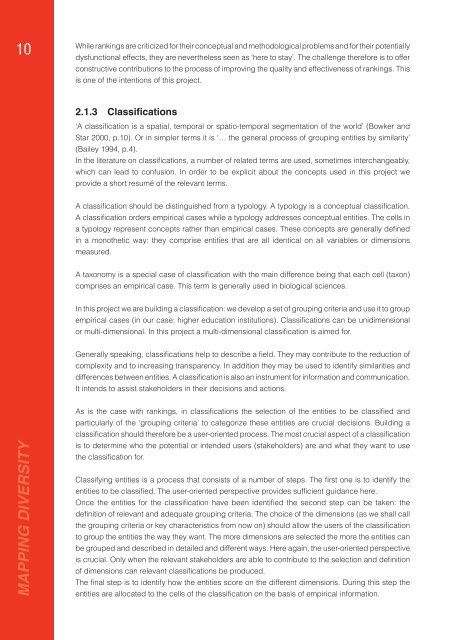Mapping Diversity: Developing a European Classification of ... - U-Map
Mapping Diversity: Developing a European Classification of ... - U-Map
Mapping Diversity: Developing a European Classification of ... - U-Map
You also want an ePaper? Increase the reach of your titles
YUMPU automatically turns print PDFs into web optimized ePapers that Google loves.
While rankings are criticized for their conceptual and methodological problems and for their potentially<br />
10<br />
dysfunctional effects, they are nevertheless seen as ‘here to stay’. The challenge therefore is to <strong>of</strong>fer<br />
constructive contributions to the process <strong>of</strong> improving the quality and effectiveness <strong>of</strong> rankings. This<br />
is one <strong>of</strong> the intentions <strong>of</strong> this project.<br />
2.1.3 <strong>Classification</strong>s<br />
‘A classifi cation is a spatial, temporal or spatio-temporal segmentation <strong>of</strong> the world’ (Bowker and<br />
Star 2000, p.10). Or in simpler terms it is ‘… the general process <strong>of</strong> grouping entities by similarity’<br />
(Bailey 1994, p.4).<br />
In the literature on classifi cations, a number <strong>of</strong> related terms are used, sometimes interchangeably,<br />
which can lead to confusion. In order to be explicit about the concepts used in this project we<br />
provide a short resumé <strong>of</strong> the relevant terms.<br />
A classifi cation should be distinguished from a typology. A typology is a conceptual classifi cation.<br />
A classifi cation orders empirical cases while a typology addresses conceptual entities. The cells in<br />
a typology represent concepts rather than empirical cases. These concepts are generally defi ned<br />
in a monothetic way: they comprise entities that are all identical on all variables or dimensions<br />
measured.<br />
A taxonomy is a special case <strong>of</strong> classifi cation with the main difference being that each cell (taxon)<br />
comprises an empirical case. This term is generally used in biological sciences.<br />
In this project we are building a classifi cation: we develop a set <strong>of</strong> grouping criteria and use it to group<br />
empirical cases (in our case: higher education institutions). Classifi cations can be unidimensional<br />
or multi-dimensional. In this project a multi-dimensional classifi cation is aimed for.<br />
Generally speaking, classifi cations help to describe a fi eld. They may contribute to the reduction <strong>of</strong><br />
complexity and to increasing transparency. In addition they may be used to identify similarities and<br />
differences between entities. A classifi cation is also an instrument for information and communication.<br />
It intends to assist stakeholders in their decisions and actions.<br />
MAPPING DIVERSITY<br />
As is the case with rankings, in classifi cations the selection <strong>of</strong> the entities to be classifi ed and<br />
particularly <strong>of</strong> the ‘grouping criteria’ to categorize these entities are crucial decisions. Building a<br />
classifi cation should therefore be a user-oriented process. The most crucial aspect <strong>of</strong> a classifi cation<br />
is to determine who the potential or intended users (stakeholders) are and what they want to use<br />
the classifi cation for.<br />
Classifying entities is a process that consists <strong>of</strong> a number <strong>of</strong> steps. The fi rst one is to identify the<br />
entities to be classifi ed. The user-oriented perspective provides suffi cient guidance here.<br />
Once the entities for the classifi cation have been identifi ed the second step can be taken: the<br />
defi nition <strong>of</strong> relevant and adequate grouping criteria. The choice <strong>of</strong> the dimensions (as we shall call<br />
the grouping criteria or key characteristics from now on) should allow the users <strong>of</strong> the classifi cation<br />
to group the entities the way they want. The more dimensions are selected the more the entities can<br />
be grouped and described in detailed and different ways. Here again, the user-oriented perspective<br />
is crucial. Only when the relevant stakeholders are able to contribute to the selection and defi nition<br />
<strong>of</strong> dimensions can relevant classifi cations be produced.<br />
The fi nal step is to identify how the entities score on the different dimensions. During this step the<br />
entities are allocated to the cells <strong>of</strong> the classifi cation on the basis <strong>of</strong> empirical information.

















